A planet in the habitable zone around Proxima Centauri? The prospect dazzles the imagination, but then, I’ve been thinking about just that kind of planet for most of my life. Proxima Centauri is, after all, the closest star to our own, about 15000 AU from the primary Alpha Centauri stars (though thought to be moving with that system). A dim red dwarf, Proxima wasn’t discovered until 1915, but it quickly seized the imagination of science fiction writers who pondered what might exist around such a star. Murray Leinster’s story “Proxima Centauri” (1935) is a clanking, thudding tale but it still evokes a bit of the magic of one of the earliest fictional interstellar voyages.
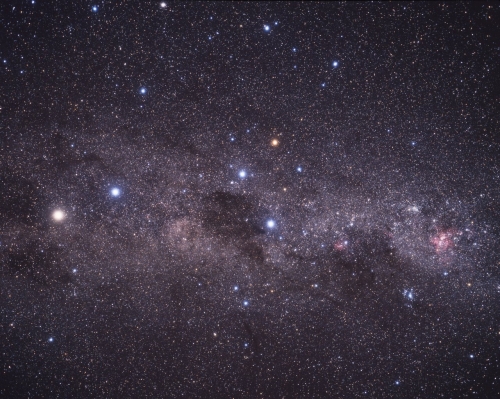
Image: This wide-field image shows the Milky Way stretching across the southern sky. The beautiful Carina Nebula (NGC 3372) is seen at the right of the image glowing in red. It is within this spiral arm of our Milky Way that the bright star cluster NGC 3603 resides. At the centre of the image is the constellation of Crux (The Southern Cross). The bright yellow/white star at the left of the image is Alpha Centauri, in fact a system of three stars, at a distance of about 4.4 light-years from Earth. The star Alpha Centauri C, Proxima Centauri, is the closest star to the Solar System. Credit: A. Fujii.
More recently, Stephen Baxter pretty much nailed Proxima Centauri b in his depiction of a just over one Earth-mass planet in the habitable zone called Per Ardua — this was in Baxter’s 2015 novel Proxima. Baxter’s planet was at 0.04 AU, and a little more massive than Earth; the real thing is 0.05 AU and 1.3 Earth masses. I would call that very nice work. Baxter has also noted, with considerable justification, that if we find a truly habitable planet in the very next system to our own, the implication is that such planets are quite common.
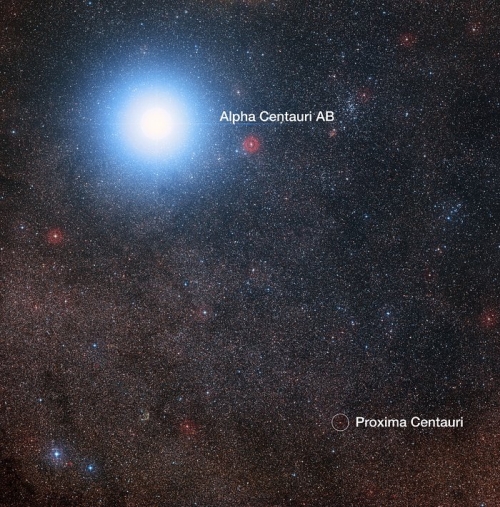
Image: This image of the sky around the bright star Alpha Centauri AB also shows the much fainter red dwarf star, Proxima Centauri, the closest star to the Solar System. The picture was created from pictures forming part of the Digitized Sky Survey 2. The blue halo around Alpha Centauri AB is an artifact of the photographic process, the star is really pale yellow in colour like the Sun. Credit: Digitized Sky Survey 2. Acknowledgement: Davide De Martin/Mahdi Zamani.
Having been at the Breakthrough Starshot meetings all this week, I’m delighted to see that we now have a potential destination; i.e. an actual rather than assumed planet around one of the stars in the system nearest to us. Finding Proxima’s planet has been a long process, drilling down to the kind of measurements that can reveal its presence. Up until now we’ve been excluding larger planets in various kinds of orbits around Proxima, but the prospect of something Earth-sized in the habitable zone remained open. I hasten to add that Breakthrough Starshot has made no decisions about its target at this point, but it’s clear that Proxima b is going to be a prime contender.

I’m going to let Guillem Anglada-Escudé, head of the Pale Red Dot project, and his collaborators describe what his team has found. Noting that uneven sampling and the longer-term variability of the star are reasons why the signal could not be confirmed from the earlier data, the researchers go on to describe these key characteristics of the planet. From the paper:
The Doppler semi-amplitude of Proxima b (? 1.4 ms?1) is not particularly small compared to other reported planet candidates. The uneven and sparse sampling combined with longer-term variability of the star seem to be the reasons why the signal could not be unambiguously confirmed with pre-2016 rather than the amount of data accumulated.
And here’s what we’ve been waiting to hear:
The corresponding minimum planet mass is ? 1.3 M? . With a semi-major axis of ?0.05 AU, it lies squarely in the center of the classical habitable zone for Proxima. As mentioned earlier, the presence of another super-Earth mass planet cannot yet be ruled out at longer orbital periods and Doppler semi-amplitudes <3 ms ?1 . By numerical integration of some putative orbits, we verified that the presence of such an additional planet would not compromise the orbital stability of Proxima b.
Image: Guillem Anglada-Escudé, head of the Pale Red Dot project and lead author of the paper on the discovery of Proxima Centauri b.
And there we are, our first assessment of a planetary system around Proxima Centauri. The team’s analysis taps into previous Doppler measurements of Proxima Centauri coupled with the follow-up Pale Red Dot campaign of 2016. The Doppler data draws on the HARPS (High Accuracy Radial velocity Planet Searcher) spectrometer and UVES (the Ultraviolet and Visual Echelle Spectrograph). The search methods and signal assessment are thoroughly discussed in the paper (citation below). Key to the effort was what Anglada-Escudé and team call “[a] well isolated peak at ?11.2 days” that appeared in the pre-2016 Doppler data. The HARPS Pale Red Dot campaign was created to confirm or refute this 11.2-day signal. And confirm it they did.
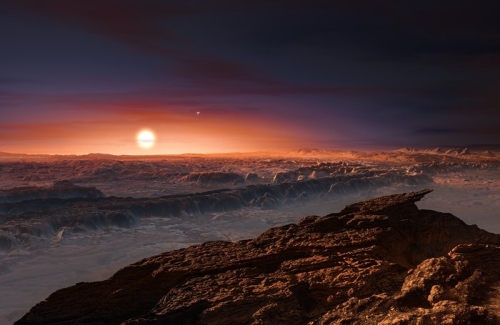
Image: This artist’s impression shows a view of the surface of the planet Proxima b orbiting the red dwarf star Proxima Centauri, the closest star to the Solar System. The double star Alpha Centauri AB also appears in the image to the upper-right of Proxima itself. Proxima b is a little more massive than the Earth and orbits in the habitable zone around Proxima Centauri, where the temperature is suitable for liquid water to exist on its surface. Credit: ESO/M. Kornmesser.
We have a long way to go before knowing whether a planet around a red dwarf like this can truly be habitable. Tidal locking is always an issue because a planet this close to its host (Proxima Centauri b is on an 11.2-day orbit) is probably going to have one side fixed facing the star, the other in permanent night. There are papers arguing, however, that tidal lock does not prevent a stable atmosphere with global circulation and heat distribution from occurring.
And what about Proxima’s magnetic field? The average global magnetic flux is high compared to the Sun’s (600±150 Gauss vs. the Sun’s 1 G). Couple this with flare activity and there are scenarios where a planet gradually has its atmosphere stripped away. A strong planetary magnetic field could, however, prevent this erosion. Nor would X-rays (400 times the flux the Earth receives) necessarily destroy the planet’s ability to keep an atmosphere.
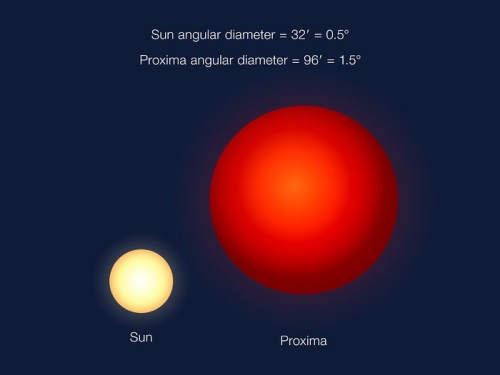
Image: An angular size comparison of how Proxima will appear in the sky seen from Proxima b, compared to how the Sun appears in our sky on Earth. Proxima is much smaller than the Sun, but Proxima b lies very close to its star. Credit: ESO/G. Coleman.
And then there’s the matter of the planet’s origins, and how that could affect what is found there. From the paper:
…forming Proxima b from in-situ disk material is implausible because disk models for small stars would contain less than 1 M Earth of solids within the central AU. Instead, either 1) the planet migrated in via type I migration, 2) planetary embryos migrated in and coalesced at the current planet’s orbit, or 3) pebbles/small planetesimals migrated via aerodynamic drag and later coagulated into a larger body. While migrated planets and embryos originating beyond the ice-line would be volatile rich, pebble migration would produce much drier worlds.
We can now hope for further data on Proxima Centauri b through transit searches, direct imaging and further spectroscopy. Ultimately, of course, we can think about the prospects of robotic exploration, the sort of thing we’ve been discussing here on Centauri Dreams for the last twelve years. No star is closer, and few will reward follow-up study more than this one. I need to get into a meeting and will have to let that wrap this up, but you can be sure there will be a lot more to say about Proxima and the entire Alpha Centauri system as the analysis continues.
The paper is Anglada-Escudé et al., “A terrestrial planet candidate in a temperate orbit around Proxima Centauri,” Nature 536 (25 August 2016), 437-440 (abstract).
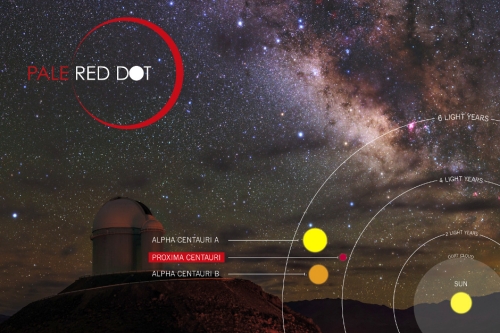



What Does “Earthlike” Even Mean & Should It Apply To Proxima Centauri b?
Article Updated: 25 August 2016
by Matt Williams
The ESO’s recent announcement that they have discovered an exoplanet candidate orbiting Proxima Centauri – thus confirming weeks of speculation – has certainly been exciting news! Not only is this latest find the closest extra-solar planet to our own Solar System, but the ESO has also indicated that it is rocky, similar in size and mass to Earth, and orbits within the star’s habitable zone.
However, in the midst of this news, there has been some controversy regarding certain labels. For instance, when a planet like Proxima b is described as “Earth-like”, “habitable”, and/or “terrestrial“, there are naturally some questions as to what this really means. For each term, there are particular implications, which in turn beg for clarification.
Full article here:
http://www.universetoday.com/130469/earthlike-even-mean-apply-proxima-centauri-b/
More like “Matt Williams begs to publish another article”, haha!
I think science reporters (and some public-facing scientists) are in danger of boxing themselves in, so to speak, when they over-simplify science.
We have a handful of parameters we know about Proxima b. The rest is speculation. “Earthlike” for instance, creates an image in people’s minds that has little to do with that possibly barren rocky floating around nearby. “Habitable” means that we should be able to “beam down” and start breathing the air right away.
The downside is that the public will be disappointed and learn to mis-trust science generally.
Well those artists impressions of possible Proxima b views that ESO & Nature put out didn’t exactly help matters.
Haha, the Huff Post nailed it:
http://www.huffingtonpost.com/dr-sten-odenwald/proxima-centauri-b-earths_b_11705746.html
I know there has been some debate as to whether or not proxima centauri formed from the same proto-stellar conglomeration as the two more Sun-like A and B members of this intriguing “nearby” triple system. Perhaps more precise astrometric measurements made by ESA’s ongoing GAIA mission will help resolve this debate once and for all. Assuming that all three of these stars formed under similar initial conditions with similar elemental compositions, would the exciting, recent discovery of an earth-mass world around proxima make the existence of planets around the A and B stars any more likely?
Speaking of the A and B stars, is there any reason to believe that one or the other of these two stars might be more likely to have a planetary system than the other, or, would the chances be about equal?
Gaia will release its first batch of data in 18 days (September 14). We’ll see what it tells about Proxima.
Looks like things possibly aren’t quite as simple as distance from the sun:
https://www.sciencedaily.com/releases/2016/08/160819153032.htm
This doesn’t surprise me. I’ve thought for a long time that the Fermi Paradox is no paradox at all.
In terms of Life on the newly discovered Proxima Centauri Planet: I expect that we will bring life to that planet when we finally arrive, chicken and eggs in our baggage.
Pessimistic? Not at all. I like the idea of a lot of empty real estate there for the taking, especially orbiting Red Dwarfs that will supply us with energy for a trillion years.
If any sort of life is found on Proxima b it can only mean life is ubiquitous in the universe as the chances of two separate cases so close together is infinitesimally small statistically . Especially what we would consider a far from optimal planet too, “hab zone” or not . If life is so common, that must increase the chances of “intelligence” , whatever that is ! Never mind “long shot” , it’s a disgrace we can’t image Proxima b now , the technology certainly exists and if designed to image just Proxima ( and the other two stars in the system ) and taking advantage of Proxima’s unique proximity, doesn’t even need to be that expensive . A circa 1m space scope and PIAA coronagraph ( matured recently through the WFIRST preformulation and on top of a decade of intensive research ) could do it with a long enough imaging period ( 1-2 years) easily possible with a bespoke telescope. . Combined with either a small spectrograph or alternatively ,to keep initial costs down ,imaging in several wavebands consistent with well recognised bio signature absorption spectra ( “Raleigh scattering” in an Earth like atmosphere , methane etc ) .Well within reach.
The discovery will most likely spur things on, the purse holders will have slightly less grip on the ‘purse string’ now that we have a little more proof of a planet around our nearest star.
To get to Proxima Centauri b via rocket will require some challenging engineering if we want to get data return in a reasonable time. The specific jet-power is the chief metric for rockets and computed as:
P/M = 4.95 * (S^2/T^3)
…with the displacement S in AU and the time T in Julian years, if we launch a probe and want it to stop via rocket-thrust, using the optimal mass-ratio of 4.42 for a power-limited rocket.
Proxima is at 267,000 AU (1.295 parsecs)
Thus, for a 100 year data-return time, the specific power is 400 kW/kg.
50 years, 3.7 MW/kg.
25 years, 40 MW/kg.
If some other braking system is available (eg. magnetic-sails or Alfven Drag-Nets) then the rocket power can be reduced. Staging also brings down the required specific power.
@Adam
I’m curious what these values are in terms of delta-V, are you able to convert them?
(I’d convert them myself if I knew how, a quick google has made me none the wiser though!)
Hi Lionel
The delta vee, for minimum specific power when braking at destination, is 3 times the average velocity. The maximum cruise speed is thus 1.5 times the average velocity. There’s two references that are useful – one is Moeckel’s 1972 paper and the other is Orth’s 2003 paper, which has an Appendix by John Trenholme that makes the computations explicit. To my knowledge a fully relativistic analysis hasn’t yet been done, so the caveat is that the results apply to speeds <0.5 c.
Data return time is, of course, the travel time plus the speed of light distance. For example, if the average speed is 0.25c, then the travel time is 4 times the distance in light-years and the data return time is (4+1) times that – in this case 21 years.
Those references are here:
Moeckel: COMPARISON OF ADVANCED PROPULSION CONCEPTS FOR DEEP SPACE EXPLORATION
Orth: VISTA – A Vehicle for Interplanetary Space Transport Application Powered by Inertial Confinement Fusion
Of course, this is limited by the assumptions of the analysis. If, for example, the acceleration phase is distance limited (i.e. laser range), then the required cruise speed will be closer to the average velocity, depending on the deceleration details. Magnetic-sails and Alfven Drag-Screens have their own unique equations of motion that need to be factored in.
The specific power for the 100 year scenario I about 3 times that of the space shuttle main engine, which I believe is the highest yet achieved by any machine. So there is hope, but, of course, we need way better isp, too.
All we need to do now is find a ‘pale blue dot’ around this ‘pale red dot’ and I will be happy.
Would a pale green dot be better in terms of finding life?
Orange sky like Mars if there IS an appreciable atmosphere, so PROBABLY a pale orange dot(I ALSO think the true color of Proxima Centaury as seen UNAIDED by the HUMAN EYE is orange(or maybe even yellow-orange), NOT red
Not nearly as red (3042K) as an incandescent light bulb (2400K), that most would say is white with a yellowish tinge. The human eye is too good at adjusting to notice much.
In response to David Cummings Post on the paper
addressing the importance of initial temperature of terrestrial
at the start of their journey as a potential habitable world.
Although the Rare Earth book did not latch on to the following “filter” they should have considering the paper referred to by D. Cummings, To their
credit the Rare Earth authors did include the Moon as requirement but not the other implication of this event mentioned below.
FILTER:
The Theia + Young Earth collision that created the moon. It has been
stated in the scientific literature that Theia’s hot dense core MERGED
with the Earth’s core, creating a Terrestrial planet with a Very Large core compared to it’s mantle. If this event is required to create Earth Like Worlds
How likely is to be repeated in G,K,F, type suns? I think the possibility of
SETI contact (taking into account the co-temporal requirement to contact another civilization) is very close to zero if core size/temperature requirement is true. As matter of fact it makes it very likely that there
maybe at present only 1 tech civ in the Galaxy.
I can see why SETI is very interested in Red Dwarfs, If they have the possibility of higher life developing in planets orbiting then their Search
ET becomes just a very long shot, as opposed to Almost no Chance.
New article on Pale Red Dot:
OPPORTUNITIES AND OBSTACLES FOR LIFE ON PROXIMA B.
https://palereddot.org/opportunities-and-obstacles-for-life-on-proxima-b/
This Proxima b world may be the first of its type detected with an ocean not of water but CO2. If the water was driven off into space and the carbonate rock vented into the atmosphere like on Venus, now that it has cooled down it may have liquefied.
It would make a very strange world indeed
After reading “OPPORTUNITIES AND OBSTACLES FOR LIFE ON PROXIMA B”, I starting thinking about comets. Proxima B, having such a close in orbit to the red dwarf star Proxima Centauri, would there be more water and other organics delivered to its surface. Since there are many sun grazing comets it would seem more likely that there would be more impacts the closer to the star the planet is. Since there seems to be no large Jupiter’s type in orbit, there should be nothing to suck up the ices that orbit further out, so would we see more comets? The ACEsat test satellite is suppose to be able to see the zodiacal dust light from nearby stars so maybe we can model the number of comets and other debris from that. It would seem to me that this could have significant impact on the possibility of organic life developing on these miniature solar systems!
The planet could have migrated in from beyond the star’s ice line which would mean it might have missed the most aggressive activity levels of Proxima’s earlier days as well as brought in its own water inventory.
The other possibility in the absence of a conveniently placed Gas Giant is that in the past Alpha Centauri A and B where closer in the past and disrupted comets into the Proxima inner system in the way Jupiter did with
Earth.
Ironically at its current distance of 15000 AU from A/B , Proxima is likely tramelling along through the inner region of those two stars shared Oort Cloud so it’s possibly still inducing a cometary bombardment though no one knows for sure about what if any form ( or indeed even the existence ) of a binary pair’s Oort Cloud.
Ashley some excellent points, what if we shrank our solar system into the red dwarf miniature solar systems that are beginning to be so common. The Proxima b would scale very close to a Jupiter if you took a 1/8th size drop and the Oort cloud would also be that much smaller. We would then end up with Proximas b being the King of the short period comets in that system as Jupiter is in ours. I would venture to guess that the atmosphere would be thick but depleted of the hydrogen envelope from flares. Oceans and layers of organic goo would make for some interesting life forms!
Very possibly. We don’t even know about our own Oort Cloud and not much more about the much nearer Kuiper belt so I think comets, individual or swarms , long or short period are pretty much an enigma to me.
In terms of the water you mention you’ve hit the nail on the head . It’s even more important to see if Proxima b, despite all the odds, has an atmosphere than what it’s made of ( although if it’s a mini Neptune that would be a bit disappointing) . It is likely to be either tidally locked or in some sort of 3:2 or 2.1 resonant orbit .
There was an article on arXiv today showing how ground based high resolution optical spectroscopy ( over a hundred hours of Keck size telescope time ) combined with high definition imaging from the JWST should be able to calculate firstly the Proxima system’s inclination from the way in which light is reflected off the planet and its phases . Thus in turn msini and the planets mass and radius which along with the star’s radius can calculate how if at all heat is transferred from the light to dark side of Proxima b. This transfer will show it has an atmosphere or/ and an ocean , if not the types . No heat transfer equals no atmosphere/ocean. Atmosphere less planet .
Touch and go as to whether the MIRI mid infrared instrument on JWST can do it and authors recommend it should be included as a priority during the JWST work up phase. Extremely clever, and a foretaste of what’s to come on the ELTs ( goodness knows what they can do with the JWST and ELTs having cobbled this all together on the far from ideal Hubble and Spitzer in just a few years ) Nobel prize stuff absolutely , but the names cited in the article are more than up to it I think.
Better than just sitting around waiting around till the ELTs, though it would be nice to know everything , but if even Proxima b has a worthwhile atmosphere that in itself is a huge discovery and means in effect anything goes. The time of simulation is passing towards that of observation at last.
Perhaps, although the timing of the migratory and Proxima’s pre-main sequence phases isn’t in Proxima b’s favor. It’s thought red dwarfs have a longer pre-main sequence high activity phase compared with our Sun, perhaps ~1 billion years. The migration phase would have ended before the solar nebula was dissipated several million years after Proxima Centauri formed (Proxima is ~4.8 billion years old), which means Proxima b would have been exposed to atmosphere eroding flares and coronal mass ejections for an extended period after migrating. Plus, despite having settled onto the main sequence, Proxima is still a very active flare star. You could speculate that if Proxima b already supported a thick gas giant-like atmosphere when it migrated inwards, possibly enough atmosphere remains (supplemented by comet impacts) to create an Earth-like environment.
Yes to all. The habitable evaporated core. Anything goes. Time for observation , though arXiv today publishes a clever way of using extended ground based high resolution optical spectroscopy combined with high definition imaging with JWST to establish if Proxima b has an atmosphere ( if not the type ) via heat transfer from day to night side. Pioneered by Ignas Snellen ( who wrote about it in detail in a previous article on this site ) with the ELTs in mind but looks like it can brought forward on lesser scopes .
All this having calculated its phase angle ( via polarisation of reflected light ) to then determine the systems’ true inclination and msini . Clever stuff. Hard to even grasp let alone do it ( and 100 hours of spectroscopy to sift through ) ! No reason it can’t be used on other close systems ( TRAPPIST comes to mind ) too.
I agree with you that the key is whether these battered M dwarf planetary systems can somehow sustain atmospheres throughout their pre and early main sequence storm.
Assuming Proxima B is going to be the target of the Breakthrough Starshot initiative, will the laser array have to be located in the southern hemisphere in order to aim at Proxima Centauri?
I wouldn’t assume Proxima Centauri is the target, but yes, Breakthrough Starshot is looking at the southern hemisphere for the beamer array. More on Breakthrough Starshot this week as I write up the recent meetings.
‘..will the laser array have to be located in the southern hemisphere in order to aim at Proxima Centauri?…’
This is not strictly true, if we had a balloon with lens/mirrors high above the laser system many more targets could be within reach, both within our solar system and those outside. Once the laser hits the balloon reflector/concentrator it has cleared >95% of the atmosphere which would cause distortion and absorption.
For those Centauri Dreams readers who are interested, my Habitable Planet Reality Check on Proxima Centauri b is now available:
http://www.drewexmachina.com/2016/08/29/habitable-planet-reality-check-proxima-centauri-b/
Given the importance of this discovery, needless to say this is just the first in what is likely to be a long series of articles to come.
I am trying to find out if the red dwarf contraction phase is linear or exponential, I found some info that it is not and that has important consequences for the habitability of PCb but then lost it. It appears to be exponential so in reality the total flux is much less allowing the planet where it is to hold on to a lot of water and most of its atmosphere.
David Kipping tweeted this: “Now back to our Proxima b transit analysis”. This COULD mean that, now KNOWING the RV amplitudes, he is CONCENTRATING on teasing out possible VERY SHALLOW transits of very short durations in the limb-darkened edges of the star.
UPDATE: He is using NASA’s PLEIDES supercomputer to do the data reduction. According to a “Cool Worlds” video on this subject, this data reduction is ALMOST COMPLETE and an ANSWER should be forthcoming in a couple of weeks!
In the event anyone wants to visit Proxima Centauri, here is where you can find it in the Milky Way galaxy – by none other than Guy Ottewell:
http://earthsky.org/space/where-is-proxima-centauri
I think they should name this planet Vesper, after the Roman god Vesper, because it represents the idea of the Vesperian Planet Type: http://www.orionsarm.com/eg-article/4922e224a740d
Proxima b may have water but the x-ray level makes it uncolonizable. That doesnt mean that there are not other planets in the proxima system. The data indicates that there are other planets in system. Even a Hoth-like ball of ice is useful.
So many interesting comments, so everything has probably been said already.
I just want to note that the (publication of the) discovery of Proxima Centauri b this month coincides with the 12 year anniversary of this awesome website, Centauri Dreams, a site dedicated especially to the Alpha Centauri system. What a coincidence!
Congratulations to you Paul and I wish you many happy discoveries to come!
Ronald, thanks for noticing that. And thanks, too, for being one of this site’s long-term readers and commenters. It’s been a pleasure. And it sure doesn’t seem like 12 years!
AND the 27’th anniversary of Voyager II’s flyby of Neptune, making this date a very easy one to remember, like July 20, which was the date of BOTH the first manned moon landing AND the date of the first unmanned Mars landing!
And another discussion on the habitability of PC b:
https://www.sciencedaily.com/releases/2016/08/160829155336.htm
Proxima b is in host star’s habitable zone, but could it really be habitable?
Meanwhile, three giant exoplanets have been found circling a binary star system:
https://carnegiescience.edu/news/discovery-one-ups-tatooine-finds-twin-stars-hosting-three-giant-exoplanets
Wednesday, August 31, 2016
Carnegie Science, Carnegie Institution, Carnegie Institution for Science,
Timothy Rodigas, TJ Rodigas
Washington, DC— A team of Carnegie scientists has discovered three giant planets in a binary star system composed of stellar ”twins” that are also effectively siblings of our Sun. One star hosts two planets and the other hosts the third. The system represents the smallest-separation binary in which both stars host planets that has ever been observed. The findings, which may help explain the influence that giant planets like Jupiter have over a solar system’s architecture, have been accepted for publication in The Astronomical Journal.
Perhaps we could colonize Proxima Centauri B (Vesper) underground.
Why “Vesper”? Sounds ok, but Italian for “wasp”
Vesper was the Roman god who the concept of the Vesperian worlds was named after:
https://en.wikipedia.org/wiki/Hesperus
http://www.orionsarm.com/eg-article/4922e224a740d
I’m still all for Per Ardua as its name just because Baxter’s fictional planet is so close to the real one.
I can’t disagree. “Through adversity…” Everything about this planet has / will involve this , from discovery despite all manner of obstacles , characterisation after a battle royal to fund suitable technology amid fearsome competition and dwindling funds and all paling into insignificance to actually visit it one day as Baxter was no doubt alluding .
“Per Ardua” , got a good ring to it and the gravitas always brought by nicely crafted Latin. The first part of a great motto too.
I still thiink we should continue humanity’s ancient tradition of naming planets ans moons after mythological characters (particularly deities of roman myth). That is why I want Vesper to be its name. Perhaps Per Ardua could, one day in the distant future when mankind has colonized Vesper, be the name of the capital city. ;-)
It could also be called Aridea, a dry world.
Given that life evolves over a few billion years. This star would have been hotter before it reached red dwarf stage. Doubt that life would have survived the pre dwarf stage, as Earth wont when the Sun expands. SO my guess is no life!. Looks for planets around type F,K stars at reasonable orbit distance.
My main concern is that someday we plant Earth life and human life on Proxima Centauri B; either above ground or underground.
Red dwarfs are low mass main sequence stars not remnants of sum type main sequence stars. https://en.m.wikipedia.org/wiki/Red_dwarf